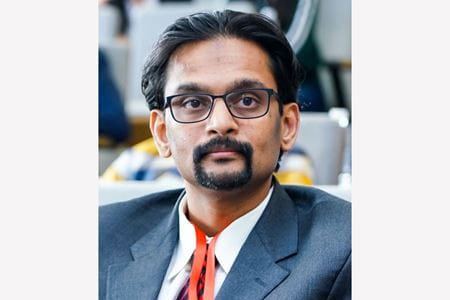The Indiana Center for Regenerative Medicine and Engineering at Indiana University School of Medicine recently hosted Kaushal Rege, PhD the Fulton Faculty Impact Professor and Chair of the Biological Design Graduate Program at Arizona State University. Rege was invited as a guest speaker for the running speaker series. Rege gave the principal digital presentation via Zoom for the COVID safe socially distanced event.
Research in Rege’s group focuses on molecular and nanoscale technologies for tissue repair and therapeutic delivery. He has published more than 90 journal papers and several book chapters. He served as co-editor for two books and multiple special issues of academic journals. Rege is an Associate Editor of two different journals, serves as Guest Member of the Editorial Board for Annual Reviews in Biomedical Engineering, and is also an inventor with several patents and ongoing patent applications. Rege was elected to the college of fellows of the American Institute of Medical and Biological Engineers in 2017. He then was awarded a New Investigator Award from the American Society for Photobiology, a Young Investigator Award from the Defense Threat Reduction Agency, and a Fulton Exemplar Faculty Award from ASU.
We sat down with Rege to discuss his presentation on Polypeptide Biomaterials for Tissue Sealing and Repair.
Can you give an overview of the topics you discussed during your talk?
I focused on two topics, the first was on the development of biomaterials that respond to light, and are able to seal incised or lacerated tissues as a potential alternative to sutures. The second topic of the talk focused on the kinds of materials and how they absorb light as they convert that light to heat in order to facilitate the sealing of the tissue that may be torn or lacerated. We also discussed potential applications for this material and the sealing approach for preventing infections that can happen at the surgical site.
From your research, what are the benefits of sealing wounds with this biomaterial as opposed to what is currently available to clinicians?
We use biomaterials that are in some cases well-characterized and we work towards understanding how they can facilitate or augment some of the tissue repair processes. The advantages of the light-based tissue sealing approach from a clinical perspective include the potential for faster surgeries, the ability to seal wounds where sutures may not lead to an optimal outcome, or when sutures may be cumbersome to use, it can lower the scarring of the tissue. In terms of the wound healing approach, it can lead to faster wound closures. The faster the wound closure happens the better it is for general tissue repair and healing, but it also helps to prevent infections that may occur within the wound
How do you hope your research will impact the future of medicine, and what’s the next step to move your research forward?
In situations like trauma, it'll give clinicians options for rapidly sealing soft tissues. It has good potential for use in combat zones in emergency medicine and surgery. Having the ability quickly seal soft tissues can lead to faster recoveries in wound healing and tissue repair. As we learn more about tissue repair in situations of slow healing, chronic wounds, trauma, acute injuries and wounds we may be able to develop different bioactive material nanoparticles that can lead to faster wound healing.
What made you interested in the field of medical engineering and the research that you do?
I come from a family of doctors, so the conversations at home with my parents were always fascinating to me growing up. Although I didn't pursue medicine, it was never far away. When I started my higher studies there was this huge revolution in biology with new findings and the human genome project. I felt that I would love to be a part of this, of all the new amazing science that was happening. And I had fantastic mentors along the way.
